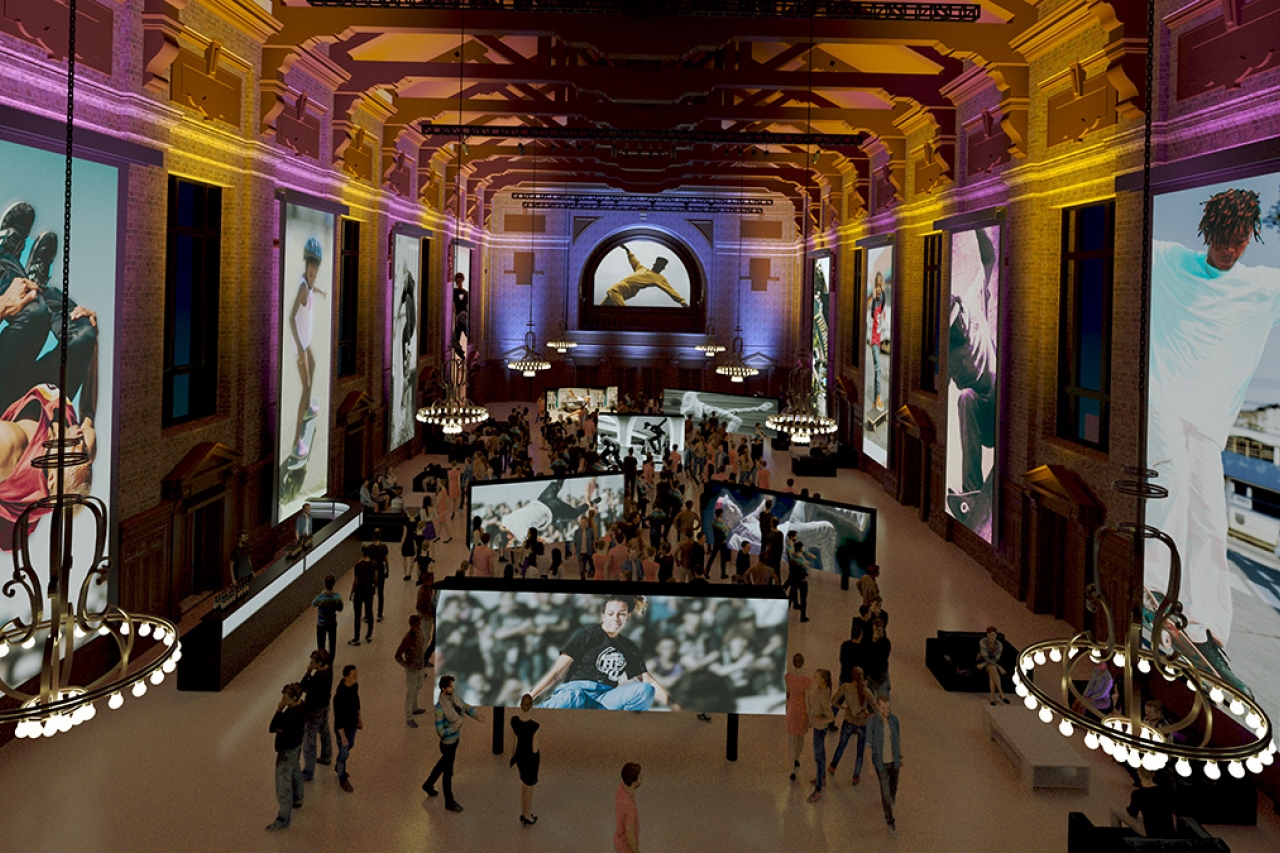Schwarzman Center to open in fall 2021, serve as a center for community life and the arts at Yale
Beyond including several spaces for students to gather together, the Schwarzman Center also plans to be a hub for the arts, offering new art galleries and performance spaces and a dance studio.

Artist’s rendering of an art exhibition in Commons. Courtesy of Yale Schwarzman Center.
As students wander past the massive building on the corner of Grove and Prospect streets, they might wonder what has changed within. Besides including a dining hall and several spaces for students to gather together, the Schwarzman Center will be a hub for the arts, offering a new dance studio, art gallery and theater.
The Schwarzman Center is renovating two buildings previously known as Commons, a Hogwarts-esque dining hall, and Memorial Hall, a hall lined with the names of Yalies who gave their lives for the country. In 2015, President Peter Salovey announced that the University would use a $150 million gift from Steven Schwarzman ’69 to remodel the building into a state-of-the-art campus center.
Since then, Schwarzman’s naming rights have repeatedly been called into question — he is the CEO of Blackstone and a loyal donor to former President Donald Trump. But in February, Salovey said Yale will not rename the Schwarzman center.
The center, set to open this fall, now houses several new facilities. These include an expansive dining hall, a bar, a dance studio, several study spots and art galleries.
“The mission of Yale Schwarzman Center is ‘to leverage dining, conversation, and the arts as part of students’ educational experience, convening people across schools, disciplines, and communities for moments of discovery and connection,’” said Garth Ross, the Schwarzman Center’s executive director. “We like this verbiage because it summarizes what students can expect to find: dining, conversation, the arts and moments of discovery and connection with people across schools, disciplines, and communities.”
Ross explained that the University was encouraged to create more arts spaces on campus in September 2014, when three student governing bodies at Yale — the Yale College Council, the Graduate and Professional Student Senate and the Graduate Student Assembly — came together and issued a joint report calling for a University-wide student center. In this report, they noted the need for more opportunities for undergraduates, graduate students and professional students to connect, collaborate and build new relationships with each other.
“The report made clear that students are looking not only for more space, but more space to make art together,” Ross said.
Several of the new student gathering spaces are inherently tied to the arts. For example, “The Underground,” a space for casual dining and entertainment, houses a stage for students to perform spoken word, a cappella or stand-up comedy. The Schwarzman Center also has enhanced technical systems to host arts exhibitions throughout the year.
In preparation for its opening, the Schwarzman Center organized several kinds of virtual arts programming this past year. In April 2020, it launched a web series called “One,” highlighting student works that were impacted by the pandemic. Another virtual offering was AREAS, an augmented reality experience featuring art, music, dance, architecture and poetry performances meant to introduce viewers to the Schwarzman Center. Ross said that this digital engagement with the arts, initiated by the pandemic, will continue to be a “pillar” of the Schwarzman Center’s arts programming.
Yet the Schwarzman Center has several new avenues for live, in-person programming. The center has turned the former Yale Banner Yearbook office into a performance space called “The Dome,” which includes technical lighting, infrastructure for visual projections and a sprung floor with Harlequin Steadfast, a slip-resistant surface, for dance. The space includes a full mirror, dance barre and changing room. The space additionally has an AV system for music and video playback, mounted speakers, a projector with a drop-down screen and PTZ camera.
The Schwarzman Center strives especially to restructure Yale’s dance scene. According to several dancers at Yale, the University is still behind in accommodating this art form, and the center may serve to bridge that gap.
Until now, Yale did not have a major dance studio — only smaller dance studios scattered across its residential colleges and other spaces. Yale’s largest dance studio so far, located on Broadway, only accommodates 15 to 18 students. By contrast, Yale’s peer institutions like Harvard, Brown and Princeton have large dance spaces that can accommodate between 30 to 75 students.
“Dance is such a powerful force on campus,” YaleDancers co-president Angelica Walker ’21 said. “Allowing dance the same resources available for other activities on campus is so important, and this new studio seems to be a way Yale is working to do just that.”
Yet Yale Undergraduate Ballet Company artistic director Matthew Schneider ’22 said though this addition of a new studio is welcomed as a move in the right direction, he does not believe it will make a large difference for dancers.
Hannah Quirk ’22, vice president of Yale dance group, A Different Drum, said that the group will definitely use the Schwarzman dance studio, especially as the smaller dance studios offer limited reservations slots and often lack amenities such as sprung floors.
“Having access to another dance space will allow us to take on more projects, hold more classes and grow as artists overall,” Quirk said. “Additionally, I think that having more studio space will democratize the dance community at Yale by making it easier for more people to get involved and for people to start new dance groups.”
A Different Drum dancer Silver Liftin ’22 said that any new dance space — especially one with amenities such as nice floors — is welcome, but she is skeptical of how much dancers will be able to use it given her experience with reserving time slots for Yale’s current dance studios. Still, she expressed that she is excited for a “beautiful studio to dance in.”
The center also has the potential to step in for other forms of performance art at Yale. Miles Goldenberg ’22, who is part of a cappella group Mixed Company, said that the additional performance space in the Schwarzman Center would be a helpful alternative to the residential college performance spaces, which make up the majority of the spaces performance groups now use.
Iyala Alai ’22, who is a member of a cappella group Pitches & Tones, said there is somewhat of a shortage of big performance venues, especially considering how many performance groups exist at Yale. She noted that groups will often perform in residential college dining halls or classrooms, whose acoustics are not always ideal.
“I think a cappella groups would like to perform [at the center] if it has the right acoustics and enough space to accommodate larger audiences,” Alai said. “I’m excited to see what these spaces are like and hopefully perform there at some point.”
“I think a lot of us would look forward to singing at a new venue on campus,” Pitches & Tones member Mathew Krick ’22 said. “Overall, I sense that a lot of students are excited to see what the Schwarzman Center will look like.”
Commons and Memorial Hall were built in 1901 as a part of the university’s bi-centennial celebration.









